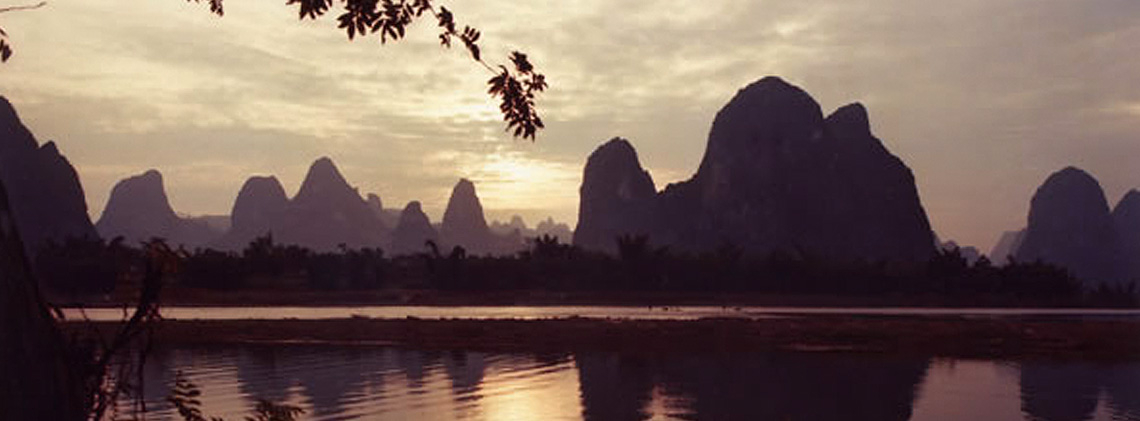
Scenic Guilin
Splendid
Chi Culture
Topic
Scenic Guilin
Located in the Guangxi Zhuang Autonomous Region, Guilin is a world renowned tourist destination and a historic city often said to have “the most beautiful scenery under Heaven.”
Guilin has a long history and was once part of the Chu state during the Warring States period (475–221 BCE). The name “Guilin” can be traced back to the Qin dynasty (221–206 BCE) when cinnamon (“gui” in Chinese) was planted throughout the area. In the Song dynasty (ca. tenth century), the city became the political, economic, and cultural center of Guangxi, which people began referring to as “Gui” after Guilin.
Green hills, clear water, unusual caves, and beautiful stones are the “four wonders” of Guilin. The hills rising from the flat ground and standing separately like jade hairpins are vividly depicted in the verse “Level ground extends in all directions, / A thousand peaks soar into the sky.” The hills of Guilin come in all kinds of shapes and their resemblance to various animals and natural phenomena has given rise to a multitude of descriptive monikers such as Camel Hill, Elephant Trunk Hill, Taming Wave Hill, and many more.
The Elephant Trunk Hill, resembling a gigantic elephant taking a drink from the river, is a landmark of the city. Legend has it that the Jade Emperor of Heaven once dispatched an expedition against the mortals. As the divine troops passed Guilin, a divine elephant fell ill and was later cured by an old physician. To repay the kindness, the elephant decided to stay in the mortal world. The enraged Jade Emperor sent Li Jing, the Pagoda-Bearing Heavenly King, to capture the disloyal animal. After a fierce battle, the elephant ran to the river to quench its thirst when Li Jing stabbed it from behind with a sword. The elephant turned into a hill and stayed in Guilin forever.
The river from which the legendary elephant drank is Li. It flows 437 kilometers from Mao’er Mountain in Xing’an through Guilin, Yangshuo, and Wuzhou into the Zhujiang (Pearl River). The Li River, with a sediment percentage as low as 0.006, is known for its extremely clear water. The section from Elephant Trunk Hill down to Yangshuo offers the most breathtaking view of the river. With fantastic rocky peaks along both sides, the landscape is like a heavenly crafted bonsai arrangement planted on earth. A popular saying goes, “the world’s finest scenery is in Guilin, and Guilin’s finest scenery is in Yangshuo.” Sailing on the Li River is like traveling in a painting.
Xu Xiake (1587–1641), a noted writer and traveler in the Ming dynasty (1368–1644), described Guilin in the following way: “There is no hill without caves, and no cave lacking its own uniqueness.” The exceptional mountain terrain in Guilin harbors many karst caves where natural multistoried pavilions have formed and underground streams run. After eons of erosion, the rock formations inside the caves have taken on various fantastic shapes. These formations, with fine, brilliantly colored patterns, are sought after as collectables with high aesthetic value.
Throughout the ages, numerous poets and painters have been inspired by the unparalleled beauty of Guilin and have left behind works inspired by it. The great Tang literatus Han Yu (768–824) praised the scenery in his poem “Seeing off Great Master Yan to Gui Prefecture”:
“Lushy green the land of the eight cinnamon trees;
South of the River Xiang this land lies.
The river like a blue silk ribbon,
The peaks like a green jade hairpin.”
Guilin has an abundance of ancient rock inscriptions. In the Longyinyan Cave area alone there are more than 200 cliff inscriptions which have earned the area the nickname of “Guilin Stele Forest.”
The famous Longji Rice Terraces in Longsheng county were first constructed in the Yuan dynasty (1271–1368). They coil around the mountain from the bottom to the top with an elevation gain of some 500 meters. Shrouded in clouds and mist at the top, the terraced fields seem to reach into the sky. The fields are divided into numerous plots ranging from as large as one mu (ca. 667 square meters) to the size of only two or three rows of seedlings. There is a joke about the large number of these terraced fields: A farmer who had finished plowing his 206 fields started to count them, but no matter how many times he counted there was always one short. At last, he decided to give up, only to find the “missing piece” under his hat as he picked it up to go home.
Many ethnic groups live in Guilin including the Zhuang, the Han, the Yao, the Miao, and the Dong. Together they have molded Guilin’s unique culture while separately they observe different festivals, rituals, and customs. Their distinctive charms are showcased in the architectural design of the Yao and Dong people, and the Zhuang’s singing festival. There is also the romantic Miao custom in which young males and females serenade each other under the moon—it is called “zouzhai” in the Miao or Hmong language and literally means “stepping on the moon.”



